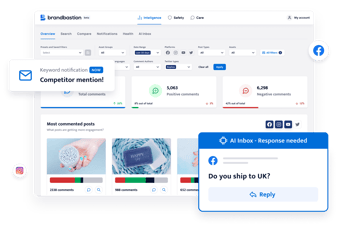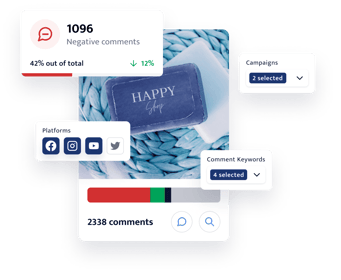
How to Use Sentiment Analysis to Optimize Your Social Media Ads
As all social media marketers know, last year Apple released an iOS 14 update that significantly impacted tracking capabilities on Facebook and Instagram, therefore affecting results across Facebook’s metrics that many marketers previously used to optimize their ads. If you’re looking for an in-depth guide to sentiment analysis on Facebook, read our article here!
We’re moving into a new age of social media marketing and these recent changes have catapulted the importance of measuring engagement sentiment to center stage as an insightful metric in how to monitor the success of a campaign.
Why Does Sentiment Matter?
1. Learn and understand your audience deeper
Tracking sentiment across your ads gives you insights into how your audience is responding to your content or product, and depending on targeting can even provide you insights into which markets resonate more or less with your content of the product.
2. Understand how your messaging is being received
A key factor in tracking sentiment is having a deeper understanding of how users are responding to your ads, specifically as it ties to the creative.
3. Discover and track important topical insights and keep a finger on the pulse of such topics
Are you seeing a spike in positive sentiment on a particular ad? Perhaps users have heard of a recent donation your company made to an important charity and it has caused an influx of positive comments on your ads. In tracking the sentiment of your engagement it’s much easier to identify what is being said across your ads. You can more easily localize which ads need your attention and which ads are doing great.
If you want to go further into the topic, we have written an entire article dedicated to what a sentiment analysis is.

How to do sentiment analysis, with an example
The best way to understand how to use sentiment analysis to optimize your ads is with practical examples! So meet Muotis - our apparel e-commerce (dummy) brand. Muotis gets most of its revenue from social advertising. They're running several ads and the team wants to know what people are saying.
During the summer season, Muotis ran conversion campaigns at scale and needed immediate feedback on how those ads were performing. By utilizing the BrandBastion platform, Muotis was able to get real-time insights into how their new ads were performing based on sentiment:
.png?width=624&name=Screenshot%20(16).png)
How to analyze negative sentiment metrics
As you can see, the first and second ads both had a fairly high volume of negative sentiment in their engagement. The platform allowed Muotis to efficiently dive into that negative sentiment deeper to better understand what was going on.
In the first ad, Muotis decided to take a closer look at negative sentiment specifically:
.png?width=624&name=Screenshot%20(17).png)
180 of the 413 total comments were labeled as negative sentiment, and you can see that the negative sentiment volumes stayed very consistent throughout the campaign dates. Muotis then looked specifically at the comments to see the trends coming up in the negative sentiment:
.png?width=1414&name=Screenshot%20(18).png)
In deciding to prioritize sentiment as a metric, the Muotis team was able to quickly identify that the main issue was that in this particular ad they were advertising an out-of-stock product - something that the marketing team had been unaware of. They immediately paused the campaign and decided to invest in the campaigns that featured products that they confirmed were in stock.
Sentiment Analysis Best Practices
1. Sentiment Analysis is an Ongoing Process
Sentiment analysis is an ongoing process. In fact, it's more than that: sentiment analysis is a continuous loop, with feedback from the output (the sentiment) going back into the input (the comments) to improve future results. Check in on campaigns regularly: at least once a day is ideal, more often if you have time! It's worth taking the time to closely monitor campaigns as they're running so you can grasp how they are resonating.
To keep an eye for sudden changes in sentiment, you should set up notifications that track comments volumes and will notify you when a campaign, ad set, or ad reaches an alarming volume.
2. Take action: change your messaging quickly when needed
Keeping a pulse on sentiment is key - but so is taking action quickly. If you get a notification that there's a spike in negative comments and you see that your creative is not resonating you need to act, fast.
Make sure to quickly tweak your messaging to ensure that you're putting out the right content at the right times and in the right places. This will help you avoid potential social media blowbacks and PR crises.
3. Engage with positive comments
Positivity usually attracts more positivity. It's a good practice to respond to positive comments - not only to generate a more optimistic environment for your ads but also to create meaningful relationships and build loyal communities that turn into repeat buyers.
4. Prioritize conversations to protect your conversions
A negative customer complaint about your service that does not get a response could deter potential customers from converting. In fact, 86% of people will hesitate to buy from a brand that has negative comments (Vendasta). So filtering conversations by negative sentiment can help you uncover the most critical issues you need to solve.
Utilize Sentiment Analysis with BrandBastion
Sentiment is undoubtedly one of the most important metrics moving into 2022, in truly understanding how your ads are performing according to the audiences you’re targeting and knowing how to best optimize your advertising in the new year.
If you’re interested in understanding how your audiences are perceiving your branding campaigns, BrandBastion provides highly accurate sentiment analysis: each and every conversation will be instantly labeled as positive, negative, neutral, or user tag only. We have built proprietary technology using classifiers trained on vast amounts of social media native content to consider context, tone of voice, and emojis, among many other factors.
You can easily filter conversations by sentiment with our platform and create custom notifications for any relevant changes in sentiment.
Start to get real-time insights into sentiment across all ads (and organic too!). Start a free trial today.

Effortless Sentiment Analysis with BrandBastion
Facebook, Instagram, Youtube,Ads & Organic covered
START FREE TRIAL